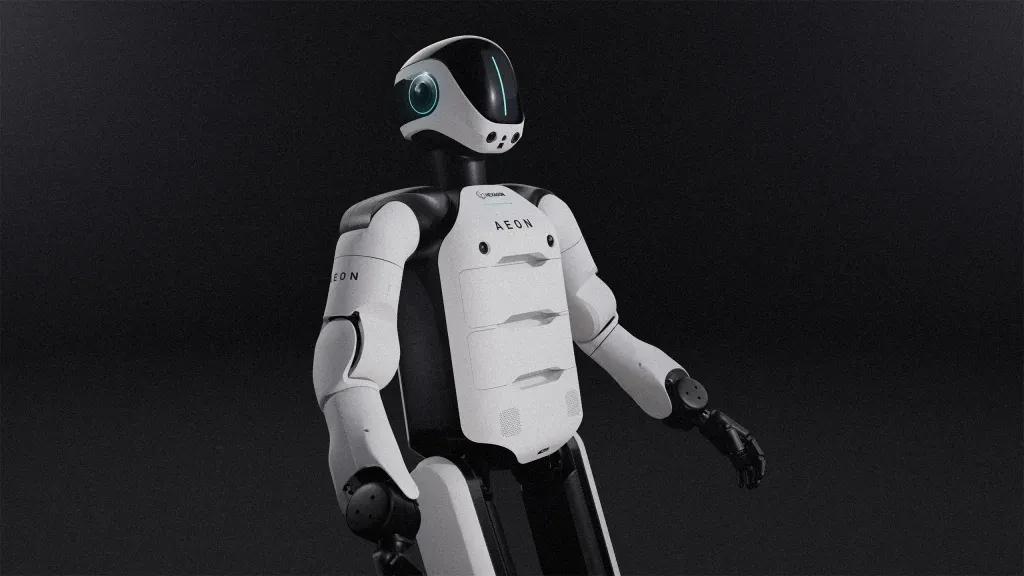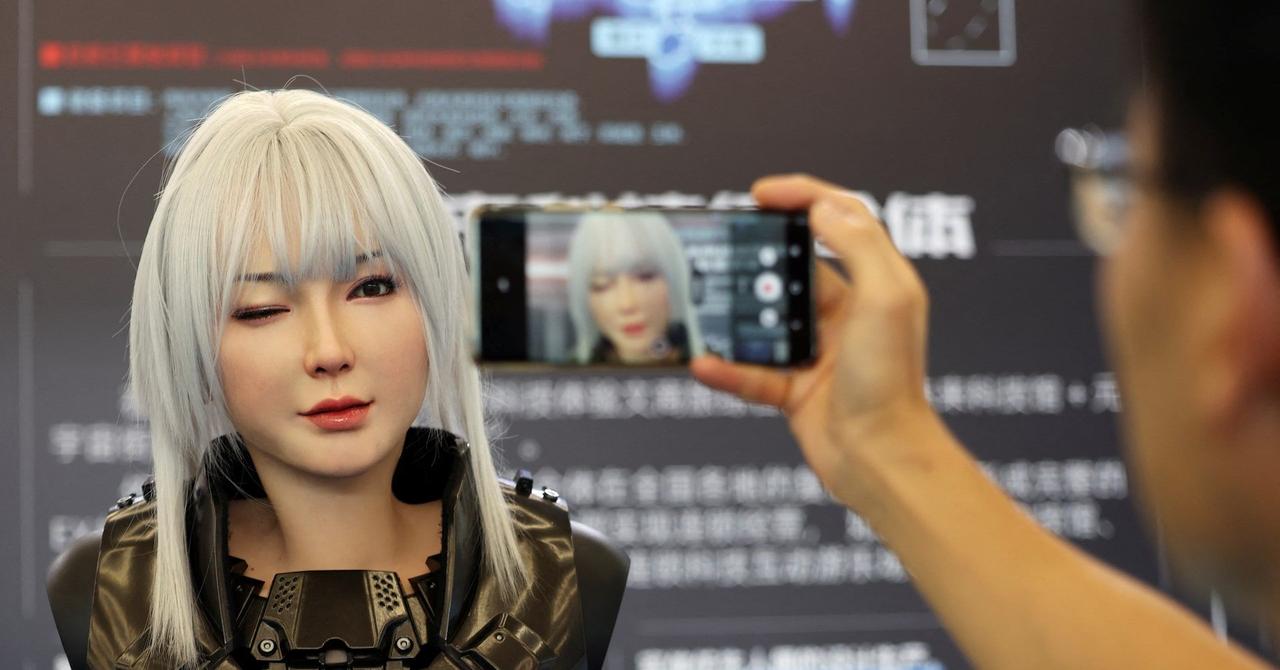Hexagon and NVIDIA Unveil AEON: A Cutting-Edge Humanoid Robot for Industrial Applications
3 Sources
3 Sources
[1]
Hexagon Taps NVIDIA Robotics and AI Software to Build and Deploy AEON, a New Humanoid
The humanoid robot can help build digital twins for manufacturing and other industries. As a global labor shortage leaves 50 million positions unfilled across industries like manufacturing and logistics, Hexagon -- a global leader in measurement technologies -- is developing humanoid robots that can lend a helping hand. Industrial sectors depend on skilled workers to perform a variety of error-prone tasks, including operating high-precision scanners for reality capture -- the process of capturing digital data to replicate the real world in simulation. At the Hexagon LIVE Global conference, Hexagon's robotics division today unveiled AEON -- a new humanoid robot built in collaboration with NVIDIA that's engineered to perform a wide range of industrial applications, from manipulation and asset inspection to reality capture and operator support. Hexagon plans to deploy AEON across automotive, transportation, aerospace, manufacturing, warehousing and logistics. Future use cases for AEON include: "The age of general-purpose robotics has arrived, due to technological advances in simulation and physical AI," said Deepu Talla, vice president of robotics and edge AI at NVIDIA. "Hexagon's new AEON humanoid embodies the integration of NVIDIA's three-computer robotics platform and is making a significant leap forward in addressing industry-critical challenges." Using NVIDIA's Three Computers to Develop AEON To build AEON, Hexagon used NVIDIA's three computers for developing and deploying physical AI systems. They include AI supercomputers to train and fine-tune powerful foundation models; the NVIDIA Omniverse platform, running on NVIDIA OVX servers, for testing and optimizing these models in simulation environments using real and physically based synthetic data; and NVIDIA IGX Thor robotic computers to run the models. Hexagon is exploring using NVIDIA accelerated computing to post-train the NVIDIA Isaac GR00T N1.5 open foundation model to improve robot reasoning and policies, and tapping Isaac GR00T-Mimic to generate vast amounts of synthetic motion data from a few human demonstrations. AEON learns many of its skills through simulations powered by the NVIDIA Isaac platform. Hexagon uses NVIDIA Isaac Sim, a reference robotic simulation application built on Omniverse, to simulate complex robot actions like navigation, locomotion and manipulation. These skills are then refined using reinforcement learning in NVIDIA Isaac Lab, an open-source framework for robot learning. This simulation-first approach enabled Hexagon to fast-track its robotic development, allowing AEON to master core locomotion skills in just 2-3 weeks -- rather than 5-6 months -- before real-world deployment. In addition, AEON taps into NVIDIA Jetson Orin onboard computers to autonomously move, navigate and perform its tasks in real time, enhancing its speed and accuracy while operating in complex and dynamic environments. Hexagon is also planning to upgrade AEON with NVIDIA IGX Thor to enable functional safety for collaborative operation. "Our goal with AEON was to design an intelligent, autonomous humanoid that addresses the real-world challenges industrial leaders have shared with us over the past months," said Arnaud Robert, president of Hexagon's robotics division. "By leveraging NVIDIA's full-stack robotics and simulation platforms, we were able to deliver a best-in-class humanoid that combines advanced mechatronics, multimodal sensor fusion and real-time AI." Data Comes to Life Through Reality Capture and Omniverse Integration AEON will be piloted in factories and warehouses to scan everything from small precision parts and automotive components to large assembly lines and storage areas. Captured data comes to life in RCS, a platform that allows users to collaborate, visualize and share reality-capture data by tapping into HxDR and NVIDIA Omniverse running in the cloud. This removes the constraint of local infrastructure. "Digital twins offer clear advantages, but adoption has been challenging in several industries," said Lucas Heinzle, vice president of research and development at Hexagon's robotics division. "AEON's sophisticated sensor suite enables the integration of reality data capture with NVIDIA Omniverse, streamlining workflows for our customers and moving us closer to making digital twins a mainstream tool for collaboration and innovation." AEON's Next Steps By adopting the OpenUSD framework and developing on Omniverse, Hexagon can generate high-fidelity digital twins from scanned data -- establishing a data flywheel to continuously train AEON. This latest work with Hexagon is helping shape the future of physical AI -- delivering scalable, efficient solutions to address the challenges faced by industries that depend on capturing real-world data.
[2]
Humanoid robot uses NVIDIA tech to run real-world factory operations
Fleet of AEON humanoid robots work inside an industrial lab, performing inspection and manipulation tasks.. As the industrial world rapidly scales up, so does the demand for precision, speed, and automation. At its annual Hexagon LIVE Global conference, Hexagon introduced AEON, a humanoid robot built in partnership with NVIDIA, designed to take on the physical and technical challenges of modern industrial operations. AEON is engineered to assist across a wide range of sectors, including manufacturing, transportation, aerospace, and logistics. It combines advanced robotics with real-time AI and simulation training to serve as a flexible, high-performance industrial assistant.
[3]
Nvidia and Hexagon's Aeon humanoid robot brings AI-powered automation to factories
At Hexagon LIVE 2025 in Las Vegas, a physical AI humanoid robot named AEON made its debut. Think Tron meets I, Robot, but powered by next-gen AI and hardware rather than movie magic. Developed by Sweden-based industrial tech giant Hexagon in partnership with Nvidia, AEON is designed for real-world industrial work. It can inspect equipment in cramped industrial corridors, navigate hazardous construction zones, and manage logistics in understaffed warehouses. Spencer Huang, Product Lead for Robotics at Nvidia and the son of CEO Jensen Huang, sees a massive opportunity in humanoids, as their form allows them to perform tasks that are dangerous and demanding for humans.
Share
Share
Copy Link
Hexagon, in collaboration with NVIDIA, introduces AEON, an advanced humanoid robot designed to revolutionize industrial operations across various sectors, addressing labor shortages and enhancing automation capabilities.
Introducing AEON: A Next-Generation Humanoid Robot
Hexagon, a global leader in measurement technologies, has unveiled AEON, an advanced humanoid robot developed in collaboration with NVIDIA. This cutting-edge robot is designed to address the growing labor shortage across various industrial sectors, with an estimated 50 million unfilled positions worldwide
1
.Technological Advancements and Capabilities

Source: Fast Company
AEON represents a significant leap forward in robotics technology, leveraging NVIDIA's three-computer robotics platform. This platform includes AI supercomputers for training foundation models, the NVIDIA Omniverse platform for simulation and optimization, and NVIDIA IGX Thor robotic computers for model execution
1
.The robot's development process utilized advanced AI and simulation techniques:
- NVIDIA Isaac GR00T N1.5 open foundation model for improved reasoning and policies
- Isaac GR00T-Mimic for generating synthetic motion data
- NVIDIA Isaac Sim for simulating complex robot actions
- NVIDIA Isaac Lab for reinforcement learning
This simulation-first approach allowed Hexagon to accelerate AEON's development, mastering core locomotion skills in just 2-3 weeks instead of the typical 5-6 months
1
.Industrial Applications and Use Cases

Source: NVIDIA
AEON is engineered to perform a wide range of industrial tasks, including:
- Manipulation and asset inspection
- Reality capture for digital twin creation
- Operator support in complex environments
The robot is targeted for deployment across automotive, transportation, aerospace, manufacturing, warehousing, and logistics sectors
2
. Its sophisticated sensor suite enables the integration of reality data capture with NVIDIA Omniverse, streamlining workflows and facilitating the creation of digital twins1
.Related Stories
Real-World Implementation and Future Prospects
AEON will be piloted in factories and warehouses, scanning everything from small precision parts to large assembly lines and storage areas. The captured data will be integrated into RCS, a platform that allows users to collaborate, visualize, and share reality-capture data using HxDR and NVIDIA Omniverse in the cloud
1
.Spencer Huang, Product Lead for Robotics at NVIDIA, sees a massive opportunity in humanoid robots like AEON. Their human-like form allows them to perform tasks that are dangerous and demanding for humans, potentially revolutionizing industrial operations
3
.Impact on the Robotics Industry
The development of AEON marks a significant milestone in the robotics industry. Deepu Talla, vice president of robotics and edge AI at NVIDIA, stated, "The age of general-purpose robotics has arrived, due to technological advances in simulation and physical AI"
1
.By adopting the OpenUSD framework and developing on Omniverse, Hexagon can generate high-fidelity digital twins from scanned data, establishing a data flywheel to continuously train AEON. This approach is shaping the future of physical AI, delivering scalable and efficient solutions to address the challenges faced by industries that depend on capturing real-world data
1
.References
Summarized by
Navi
[2]
Related Stories
Nvidia Unveils Groot N1: A Groundbreaking Foundation Model for Humanoid Robotics
19 Mar 2025•Technology

Nvidia Unveils Isaac GR00T Blueprint: A Leap Forward in Humanoid Robotics Development
07 Jan 2025•Technology

NVIDIA Unveils Cosmos Reason and Advanced AI Models for Robotics and Physical AI Applications
12 Aug 2025•Technology

Recent Highlights
1
Google launches Gemini 3 Flash as default AI model, delivering speed with Pro-grade reasoning
Technology

2
OpenAI launches GPT Image 1.5 as AI image generator war with Google intensifies
Technology

3
OpenAI launches ChatGPT app store, opening doors for third-party developers to build AI-powered apps
Technology





